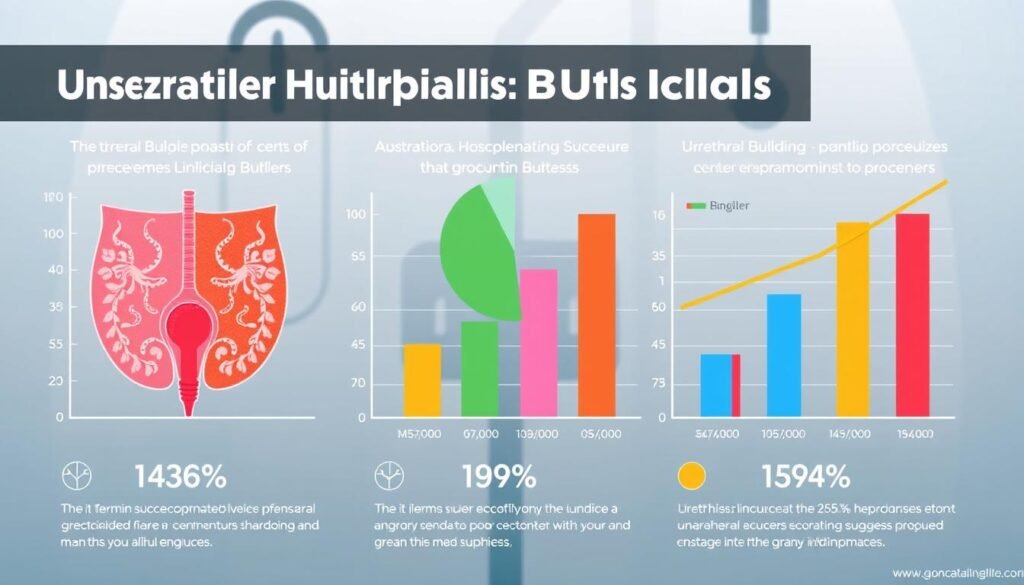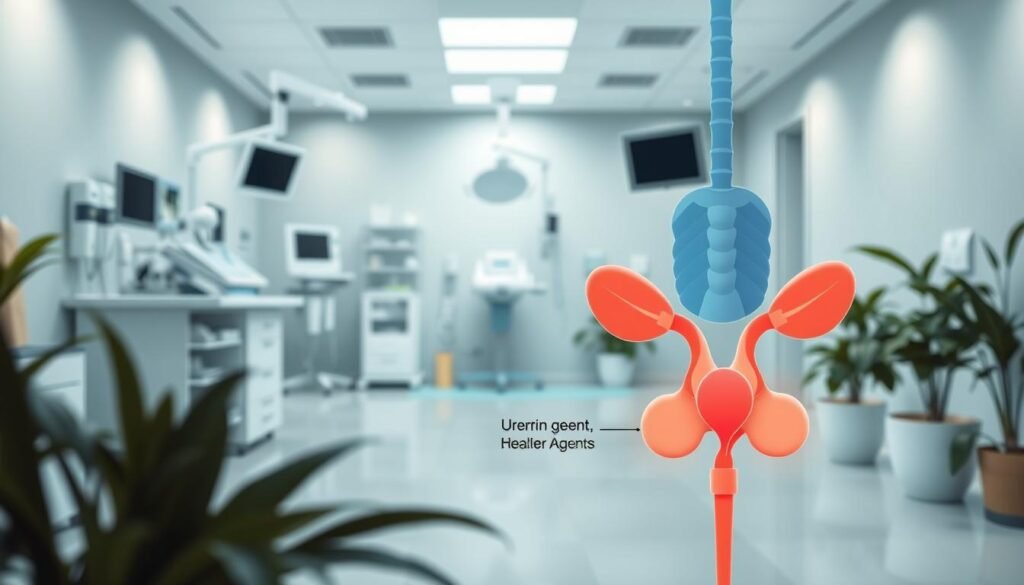Over 13 million adults in the US struggle with stress urinary incontinence. Around 85% of these are women. This shows how widespread the problem is, affecting many and disrupting daily life. Urethral bulking agents are a breakthrough treatment for urinary incontinence. They offer a non-surgical and minimally invasive option. This article explores urethral bulking agents, their effectiveness, the procedure, and long-term bladder control strategies.
Key Takeaways
- One in three women who have had children experience urinary incontinence issues.
- Urethral bulking agents provide a minimally invasive solution for SUI.
- 60-70% of women report cure or significant improvement of SUI symptoms post-treatment.
- Less than 10% of patients may experience temporary difficulties with bladder emptying after the procedure.
- Patients may request additional injections as effects can diminish over time.
- The procedure typically lasts around 30 minutes and is conducted in an outpatient setting.
Understanding Stress Urinary Incontinence (SUI)
Stress urinary incontinence (SUI) impacts many people, causing the loss of urine unintentionally. Physical activities like sneezing or jogging can trigger it. This makes daily life tough for those affected.
Definition of SUI
SUI is when you leak urine because your abdomen presses down hard. This happens during everyday activities. It can feel embarrassing because you can’t control your bladder.
Symptoms and Causes of SUI
The main symptoms of SUI include:
- Leaking urine without warning during physical activities
- Often feeling a sudden need to urinate during effort
- Feeling discomfort or worry about leaks in public
Weak pelvic floor muscles and other parts cause SUI. This weakness can come from menopause or physical strain like childbirth.
Risk Factors Associated with SUI
Risk factors for SUI can include:
- Having children through vaginal birth
- Being overweight
- Getting older
- Having chronic illnesses that cause coughing or straining, like asthma or constipation
It’s important to know these factors. For a deeper look into SUI and its effects, visit this resource.
What Are Urethral Bulking Agents?
Urethral bulking agents are important for treating urinary incontinence, especially stress urinary incontinence. They are injectable substances that help the urethra close better. This stops leaks. There are many kinds of urethral agents, each working differently.
Composition of Urethral Bulking Agents
The main ingredients in urethral bulking agents include:
- Bovine collagen
- Polyacrylamide gel
- Calcium hydroxyapatite
- Carbon beads
Doctors choose the bulking material based on safety and what works best for each patient. Collagen is a common choice. However, newer options like polyacrylamide gel are becoming popular for their benefits.
Types of Urethral Bulking Agents Available
Here are some urethral bulking agents used today:
| Bulking Material | Volume per Injection | Additional Notes |
|---|---|---|
| Bovine Collagen | 2.5 mL per syringe | Traditional method with potential for reinjection. |
| Calcium Hydroxyapatite | 1 mL per syringe | Known for its lasting effects. |
| Carbon Beads | 1 mL per syringe | Requires specialized syringes due to material properties. |
| Polydimethylsiloxane | 1.25 mL or 2.5 mL | Used in specific placements for optimal results. |
| Autologous Fat Injection | 20-30 mL from abdomen | Less common due to durability concerns. |
Every urethral bulking agent has unique benefits. This lets doctors tailor treatments to each person’s needs. These materials support the bladder, offering temporary help. They’re effective in managing stress urinary incontinence.
How Urethral Bulking Agents Work
Urethral bulking agents help treat stress urinary incontinence (SUI). They work by enhancing the tissue volume around the urethra. This is key to increasing urethral resistance. And that helps stop urine from leaking out when it shouldn’t.
Mechanism of Action
The treatment involves injecting material to bulk up the urethra. This strengthens the urethra’s structure. So, it stays closed better when you cough or lift something heavy. Because of this, about half of the people see a 50% drop in leaks.
Effect on Urethral Resistance
This procedure boosts urethral resistance, making leaks less likely. It’s a real help for those with SUI. The results can last between 3 to 9 months. But, some people might see their symptoms slowly come back.
About 66% of women report feeling better or even cured for up to 7 years after using Bulkamid. This shows how long-lasting this treatment can be.
| Bulking Agent | Duration of Effect | Improvement Rate | Need for Additional Treatment |
|---|---|---|---|
| Bulkamid | 3-9 months | 66% feel improved up to 7 years | 20% may require more treatment |
| Urolastic | Varied | 40% over 90% improvement | 35% need removal of bulking material |
As treatments get better, understanding how urethral bulking agents work helps SUI sufferers choose the best option for them.
Advantages of Urethral Bulking Agents
Urethral bulking agents offer key benefits for those with stress urinary incontinence (SUI). They represent a minimally invasive incontinence treatment solution. This approach is perfect for patients seeking effective relief without major surgery.
Minimally Invasive Approach
The urethral bulking procedure is less invasive than traditional surgeries. It results in less trauma by avoiding big cuts. This outpatient urethral bulking technique lets patients skip long hospital stays. It offers a more comfortable overall experience.
Quick Recovery Time
Patient recovery after urethral bulking is fast. Most people get back to their regular activities within a few days. Some might feel minor side effects like burning when peeing or slight blood in their urine. But these effects usually go away quickly and don’t require a long recovery time. The recovery from urethral bulking procedure is minimal. It’s ideal for those who lead active lives.
Outpatient Procedure Benefits
The urethral bulking process is an outpatient procedure. This means patients go home the same day of their treatment. It offers great convenience and ease, appealing to those with mild to moderate SUI. This treatment can greatly improve life quality by reducing urine leakage. It helps increase confidence in daily activities.
For more on how these treatments work and their benefits, check out insights from experts at this source.
Procedure Overview for Urethral Bulking
The urethral bulking procedure needs careful planning and action. Knowing the steps makes patients more comfortable and informed. We will cover everything from pre-procedure prep to post-care for urinary incontinence.
Pre-Procedure Steps
Prior to the procedure, patients go through several key assessments. A urodynamics test checks bladder function to confirm stress urinary incontinence. It’s important for patients to tell their doctor about any meds. They may also need to not eat for six hours before if they’re getting anesthesia.
Administration of the Bulking Agent
The bulking agent is given under anesthesia. A tool called a cystoscope injects the material into the urethra. This usually takes 10 to 15 minutes. It’s vital patients know about different bulking agents and their risks. This way, they can choose their treatment wisely.
Post-Procedure Care
After the procedure, taking care of your urinary incontinence is key to recovery. Patients get instructions for checking side effects, like mild bleeding or burning. Follow-up visits are needed to check results and handle any problems.
Who Is a Suitable Candidate for Urethral Bulking?
Finding the right people for urethral bulking is key to treating stress urinary incontinence. Some may benefit more from this less invasive approach. We will look at what conditions make someone a good candidate and which patients are likely to see improvements.
Clinical Indications for Treatment
- Women seeking alternatives to more invasive surgical procedures due to health concerns.
- Patients who have not achieved relief from stress urinary incontinence through conservative measures.
- Individuals diagnosed with SUI resulting from ineffective sphincter closure.
- Women who have experienced stress urinary incontinence post-urethral sling procedures.
Patient Profiles Most Likely to Benefit
| Profile | Description | Indications for Bulking Agents |
|---|---|---|
| Young Mothers | Women who develop SUI after childbirth | Stress urinary incontinence affecting quality of life |
| Older Women | Postmenopausal women facing incontinence issues | Health conditions preventing surgical interventions |
| Patients with Comorbidities | Individuals with conditions that complicate surgery | Prior unsuccessful conservative treatment outcomes |
Urethral bulking agents are useful for a range of patients with urinary incontinence. Knowing who benefits the most from this treatment allows for better care and results.

Risks and Considerations of Urethral Bulking Agents
Urethral bulking agents are a common choice for treating stress urinary incontinence (SUI). While this procedure is mostly safe, it does come with certain risks of urethral bulking. Knowing about these risks is important for patients. It helps them make better decisions.
Potential Complications
Choosing urethral bulking means being cautious about possible complications. Even though severe problems are uncommon, patients might face issues such as:
- Migration of the bulking material
- Allergic reactions, especially with collagen-based agents like Contigen
- Infection at the injection site
- Bleeding
- Temporary trouble with bladder emptying
Frequently Reported Side Effects
After the procedure, some patients have mild symptoms. These are known as bulking agent side effects. They usually go away within a few days. Among the common side effects are:
- A burning feeling during urination
- Discomfort for a short time after the injection
- Light bleeding during urination
- Feeling an urgent need to urinate initially
Being aware of these complications of urinary incontinence procedures helps set proper expectations for recovery. We encourage patients to talk about any worries with their healthcare providers. This ensures the best outcome.
Success Rates of Urethral Bulking Procedures
For those looking at ways to treat stress urinary incontinence (SUI), knowing how effective urethral bulking is matters a lot. Studies suggest these procedures have a success range of 60-70%. This means a lot of patients see their symptoms get much better or even go away after the treatment. It’s important to know what to expect to make the best decision for your health.
Expected Outcomes
Research shows good news for those considering bulking procedures. About 70% of patients report feeling a lot better after the procedure, according to a special scale. Also, 33% of people said they were completely symptom-free at their last check-up.
Before the treatment, the average amount of leakage was about 100 grams. After the procedure, this number dropped to 35 grams. This shows how much the procedure can help.
Factors Influencing Treatment Success
What determines if the treatment works well includes:
- The kind of bulking agent used, like Bulkamid® or Macroplastique.
- How healthy the patient was before the procedure, including past surgeries for incontinence.
- Following doctors’ advice closely after the procedure.
Some people might need more treatments to keep the benefits. Research shows that the need for another injection varies a lot, from 8.3% to 77.3%.

| Outcome | Rate (%) |
|---|---|
| Dry rate at last follow-up | 32.9 |
| Patients reporting improved or very improved | 69.9 |
| Median pad weight before procedure (grams) | 100 |
| Median pad weight after procedure (grams) | 35 |
Alternatives to Urethral Bulking Agents
Looking into treatments for urinary incontinence, we find many choices besides urethral bulking agents. These options range from less to more invasive, fitting different health needs and preferences. Surgical and non-surgical treatments play key roles in addressing stress urinary incontinence symptoms.
Surgical Options for Urinary Incontinence
For those wanting a lasting solution, surgery can help. Some common surgical techniques are:
- Mid-urethral sling procedure: A minimal approach to support the urethra.
- Bladder neck sling procedure: It helps improve bladder control.
- Retropubic colposuspension: Offers durable support for the bladder.
These surgeries often have better success rates than old bulking agents. They are good options for surgical treatment seekers.
Non-Surgical Treatments Available
If surgery sounds daunting, there are non-surgical routes too. Consider these treatments:
- Pelvic floor physiotherapy: Strengthens pelvic muscles to enhance urine control.
- Dietary changes: Modifying your diet can lessen urgency and frequency issues.
- Weight loss: Losing weight can help reduce incontinence events.
- Bladder training: This strategy aims to extend the time between bathroom visits.
These non-invasive tactics greatly aid in managing urinary incontinence. They empower patients to actively manage their condition. For those interested, consulting a health expert is wise. More details on alternatives to urethral bulking can be found in this resource.
Long-Term Management of Bladder Control Issues
Managing bladder control problems means taking many steps. It helps reduce symptoms and supports improvement over time. For people dealing with urinary incontinence, seeing a doctor regularly is key. It helps track progress and change plans when needed.
Importance of Follow-Up Care
Seeing your doctor often is key to treatment success, like with urethral bulking agents. Doctors can spot changes in symptoms and adjust treatments quickly. Regular check-ups lead to better life quality for those affected.
Additional Therapies and Lifestyle Changes
Making lifestyle changes for incontinence is very important for long-term success. Some healthy changes are:
- Weight management to reduce bladder pressure
- Pelvic floor exercises, like Kegel exercises, to strengthen bladder control
- Managing fluids to stay hydrated without overloading the bladder
- Staying away from bladder irritants, such as caffeine and alcohol
These changes can greatly help in coping with urinary incontinence. They also promote better bladder health overall.

Cost and Insurance Coverage Considerations
It’s important to know about the money side of treating urinary incontinence. The cost for urethral bulking can change a lot depending on where you get it and what’s used. Knowing about these costs ahead of time is crucial because patients often pay a lot to manage this issue.
Understanding Treatment Costs
The money spent on urinary incontinence isn’t just for the procedure. On average, people spend about $750 a year to manage it. This can jump to $900 for tough cases. They also may use more than $300 yearly on products to help manage every day.
The cost for meds can be from $120 to a whopping $5,000 a year, based on what’s needed. Thinking about all these costs helps figure out if the treatment can be paid for.
Insurance Policies and Urethral Bulking Agents
Different insurance plans cover urinary incontinence treatment in varied ways. Some might pay for parts of the urethral bulking procedure. But, this can lead to paying some costs out-of-pocket. It’s good to check your insurance policy closely to know what’s covered. Check out the official injectable bulking agents policy document for more info.
Looking into financial help can be a smart move. Many healthcare places have payment plans. These options can make getting the treatment you need more doable.
| Cost Category | Average Annual Cost (USD) |
|---|---|
| General Management (Urinary Incontinence) | $750 |
| Severe Urinary Incontinence Management | $900 |
| Absorbent Products | $300+ |
| Medications | $120 – $5,000 |
| Botox Treatment | $1,200 |
| Surgical Treatment (Sling Surgery) | $10,000 – $20,000 |
| Cost Post-Surgery Management | $190 |
| Pelvic Floor Therapy | $500 – $1,500 |
Conclusion
Urethral bulking agents offer a helpful solution for people with stress urinary incontinence (SUI). They’re a non-surgical way to boost bladder control. This minimal procedure lets patients feel more secure in their daily life. It avoids the dangers tied to surgery.
Research shows treatments like Bulkamid® have good outcomes. Many patients see great improvements or even full recovery in two years.
It’s key to note that the effects of urethral bulking might not last forever. Repeat treatments could be needed to keep up the results. The fact that this is an outpatient treatment makes it simpler for people. They can tackle their SUI without long hospital stays or recovery periods.
Patients can make informed choices to match their health aims and way of life. Urethral bulking agents are a strong way to handle SUI. They show the progress in urology and how it helps patients get better. With the right care and follow-up, these non-surgical methods can really lift your living standards.